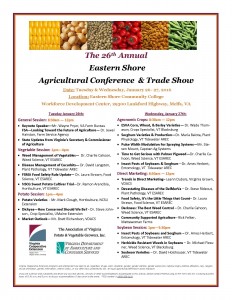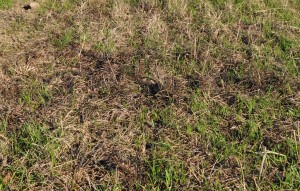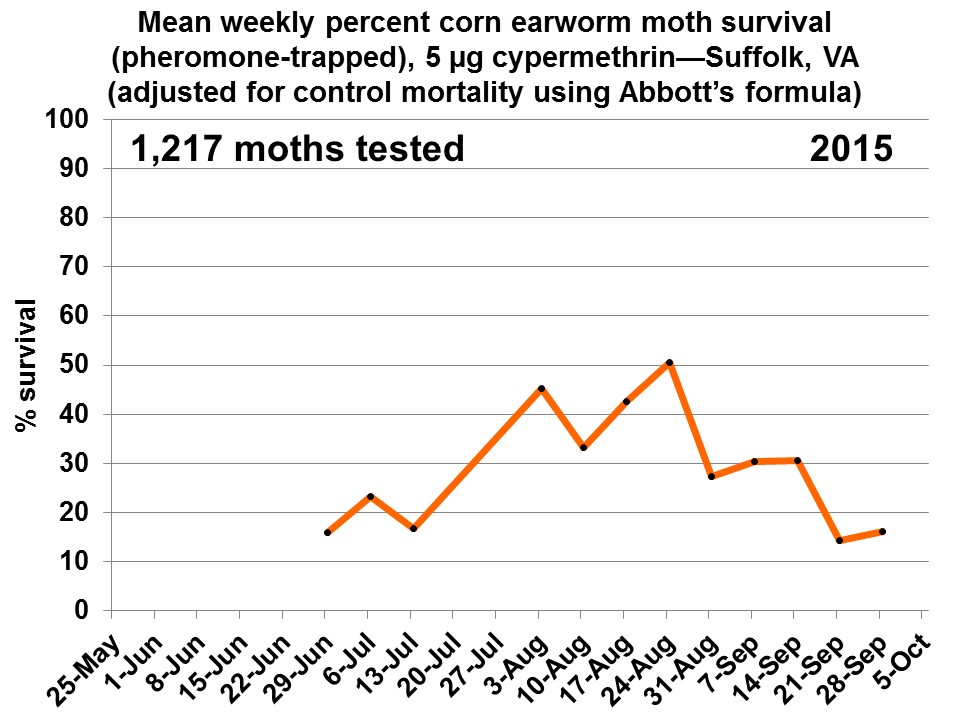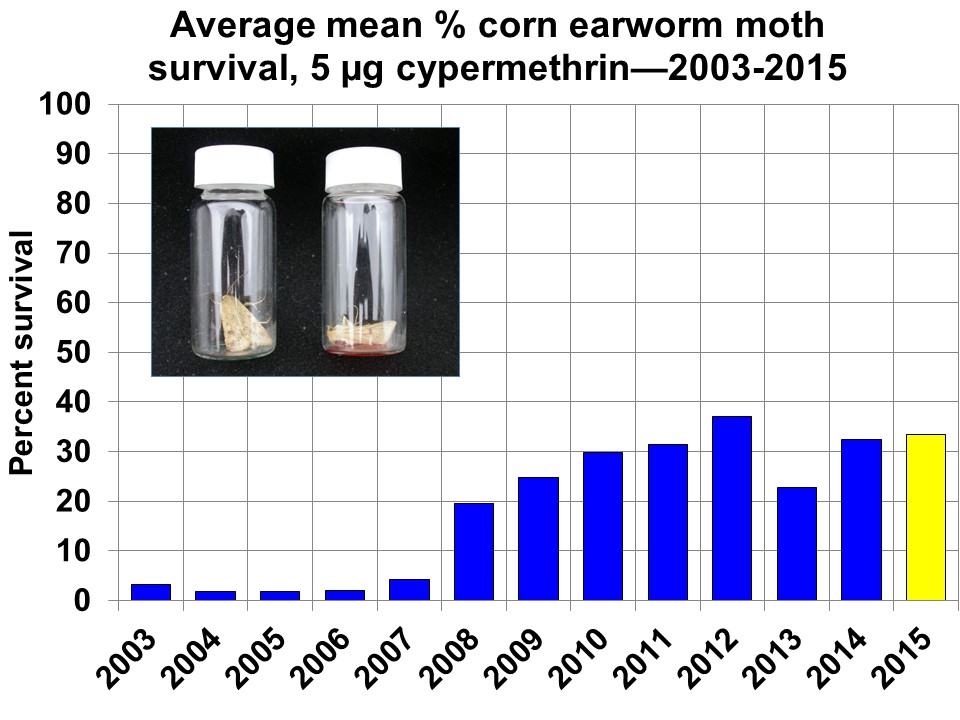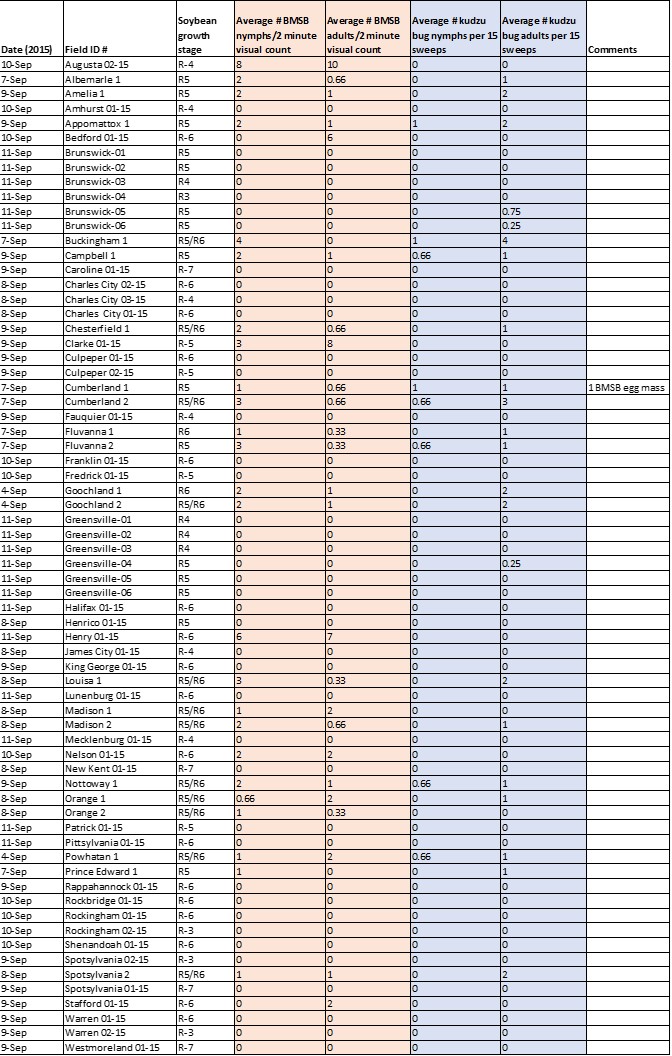Join Virginia Tech, Virginia Cooperative Extension, the Virginia Association of Potato and Vegetable Growers, and Industry to hear updates, research information, and innovative products for grain, oilseed, and vegetable crops important to Virginia’s Eastern Shore on January 26 and 27, 2016. This event is free and open to the public. Announcements concerning conference updates, weather delays and/or closings, etc. will be made at: https://www.facebook.com/EasternShore.Soils. Highlights of the program can be found in the attached flyer.
Category Archives: Pest Group
Eastern Shore AREC Specialist Day
Join us next week, November 17th, at the Eastern Shore AREC (33446 Research Drive, Painter, VA, 23420) for Weed Science Specialist Day. Topics will include new herbicide technology and control of herbicide-resistant Italian ryegrass in wheat. The event will begin at 10:00am and conclude at 12:00pm. Lunch will be served promptly following the meeting. Please RSVP to Ursula Deitch (ursula@vt.edu) or Theresa Long (tmjlong@vt.edu) by Friday if you are interested. See the below flyer for more details.
Herbicide-resistant Italian Ryegrass
With harvest in full swing, it is hard not to forget about weed control in wheat. Primarily of concern is herbicide-resistant Italian ryegrass. In the past, ACCase- (Hoelon) and ALS-inhibiting (PowerFlex and Osprey) herbicides provided control of this weed. However, Italian ryegrass biotypes resistant to these products have developed, but that is not to say these herbicides will no longer work in your area. For example, Osprey is still effective throughout most of Eastern North Carolina, but once you move into the Piedmont, ryegrass control by Osprey is hit or miss. In areas with known ALS-resistant Italian ryegrass, Zidua is suggested delayed-preemergence. Delayed-preemergence means 80% of germinated wheat seeds have a shoot at least ½-inch long. If applied prior to this stage, injury may occur. Zidua is a seedling-shoot inhibitor and will not control emerged weeds, therefore, it is important for fields to be clean prior to application. Axiom applied spike (applied preemergence, Axiom can cause severe injury) also controls Italian ryegrass if a timely activating rainfall is received following application. Another option on no-till or minimum-till fields (where stubble from previous crop has not been incorporated) is Valor SX applied preplant. Valor must be applied at least 7 days prior to wheat planting and should be applied in combination with either paraquat or glyphosate to control emerged weeds. Tillage should not be performed after Valor SX is applied. Italian ryegrass control by Finesse is variable and growers should expect only suppression. If Finesse is applied, plant only STS-soybean following wheat harvest. Postemergence options for Italian ryegrass include Axial XL and Osprey. Although most Italian ryegrass is Hoelon-resistant, Axial XL (also an ACCase-inhibiting herbicide) still seems to work in most areas. Osprey may also control Italian ryegrass in areas yet to develop resistance and will also control small bluegrass.
Soybean Seed Quality Continues to Deteriorate
The warm and wet September combined with early planting of early-maturing varieties have led to some rather severe seed quality problems in soybean this year. Our harvest to date indicates that seed quality in our Northern Piedmont is pretty good, but declines as one moves south. There also seems to be a good correlation with lack of rotation, earlier maturity groups, and earlier planting showing most of the problems. The issues can usually be attributed to the diseases phomopsis seed decay and purple seed stain, which I’ll describe in more detail below. Other diseases such as Alternaria, anthracnose, and frogeye leaf spot can also cause seed discoloration and quality issues, but are less common. The bottom of the plant usually has more seed decay than the top. But if harvest is delayed, the entire plant will be infected.
Phomopsis Seed Decay. When soybeans mature during warm and wet conditions, we can expect seed quality to deteriorate. Because this disease develops more rapidly on plants that are maturing under warm and wet conditions, we usually have more problems with early-maturing varieties. We can however have seed decay on our later- maturing varieties if October is warm. Although pods can be infected earlier, seed decay does not usually begin until after physiological maturity (R7).
Infected seed are shriveled, elongated, and c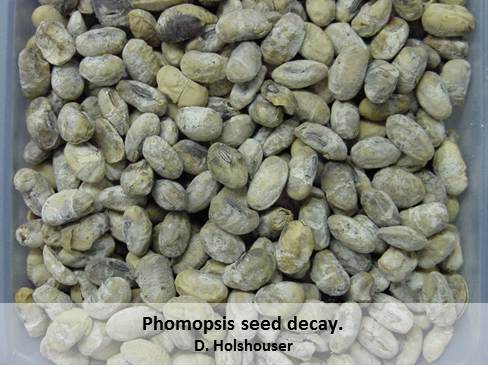 racked. Severely infected seed may appear white and chalky. The fungus secretes enzymes that degrade the seed coat proteins. Test weight can be lower. High occurrence of these seed can lead to discounts or rejection.
racked. Severely infected seed may appear white and chalky. The fungus secretes enzymes that degrade the seed coat proteins. Test weight can be lower. High occurrence of these seed can lead to discounts or rejection.
There are a few things that can be done to reduce the disease incidence. It resides in the soil and on infected residue. So, rotation is very important. More decay will occur in a crop deficient in potassium, infected with viruses, and heavily attacked by insects. Later-maturing varieties and later planting dates that delay maturity into the cooler parts of the year will reduce the incidence. Still, timely harvest is the best management strategy. The longer you leave the soybeans in the field, the worse the disease. So, only plant as many early varieties as you can harvest in a timely manner. Foliar fungicides will decrease the incidence of seed decay if applied from pod development (R3-R4) to early seed filling stages (R5). My experience is that a single R3 will do little to prevent seed decay; it will usually take a second application at R5.
Purple Seed Stain. Purple seed stain is caused by the organism Cercospora kikuchii, the same organism that causes Cercospora blight. Before maturity, fields with Cercospora blight can be recognized by reddish leaves and reddish purple blotches on the stem and leaf petioles. When severe, defoliation of the upper leaves of the plant will take place. In many cases, the blotching progressed up the stem and to the pods.  Dark, nearly black pods may appear on some varieties. Once it progresses to the pods, there is a higher likelihood that the seed will be stained.
Dark, nearly black pods may appear on some varieties. Once it progresses to the pods, there is a higher likelihood that the seed will be stained.
Purple seed stain is very noticeable. The seed will contain pink to pale purple to dark purple splotches, which can cover the entire seed coat. The purple stain itself does not reduce yield, but seed with nearly 100% discoloration may be lower in oil and higher in protein. A lot of staining can result in discounts. Germination of seed with 50% or more staining will likely be delayed.
Usually, the disease first appears on the plant during early seed development. If conditions are right (average temperatures over 80o for several days), then the disease will build up rapidly. Other weather factors do not generally affect seed 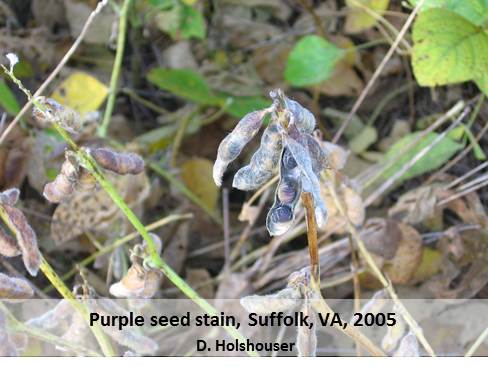 infection. Severity of the infection is largely related to amount of infected leaf debris and residue. Therefore, rotation with a non-legume crop is critical for control.
infection. Severity of the infection is largely related to amount of infected leaf debris and residue. Therefore, rotation with a non-legume crop is critical for control.
Other control measures include variety selection, planting high quality seed free of visual staining, and fungicides. Varieties differ in their susceptibility of Cercospora kikuchii, but that information is rarely available in seed catalogs. We routinely evaluate purple seed stain in our variety tests. Fungicides will give some control if applied during pod or seed formation.
Helicoverpa zea (corn earworm/bollworm) adult vial test update for Sep. 24, 2015
We’re not catching many moths in our pheromone traps this time of year, but we are still conducting the adult vial tests on those that we do catch. We are currently seeing many more dead moths after 24 hours of exposure to the pyrethroid insecticide, cypermethrin, at the 5 microgram per vial rate. Less than 20% as you can see in the line graph below. For the season, the average survival rate is 33.4% (bar chart, below).
Sugarcane aphids found in Isle of Wight sorghum field (Sep. 18, 2015)
Another Virginia county has been found with sugarcane aphid in sorghum. Please see the attachment for more details. SCA_advisory_Sep_18_2015
Sugarcane aphids found in sorghum field in Suffolk, Virginia
Dr. Ames Herbert confirmed the presence of sugarcane aphids, Melanaphis sacchari, in a sorghum field at the Tidewater Agricultural Research and Extension Center in Suffolk, Virginia, on Sep. 17, 2015. Sugarcane aphid spreads as winged adults on wind and storm fronts so infestations can spread rapidly—so to be on the safe side, sorghum fields should be scouted.
There are several other aphid species that can infest sorghum but sugarcane aphid can be differentiated from the others being smooth, cream yellow, with two, short dark cornicles (“tailpipes”) on the hind end.
Research by Mike Brewer, Texes AgriLife, and David Kerns, LSU, has provided the most up-to-date Econominc Injury Level (EIL) of 50 to 125 aphids per leaf at sorghum prices of $4/bu; and the currently recommended Economic Threshold (when the insecticide needs to be applied to prevent the population from reaching the EIL) of 25 – 30% infested plants with 50 aphids per leaf.
After heading, according to work in other states, one of the more effective insecticide products is Sivanto (Bayer CropScience). Please refer to the Section 2(ee) Recommendation for the lower (but effective) rate of Sivanto @ 4-7 oz/A here: http://www.cdms.net/ldat/ldC4K023.pdf (please take note of the pre-harvest intervals and other directions found in the Section 2(ee)).
BMSB and kudzu bug soybean scouting report update for Sep. 16, 2015
Scouts Ed Seymore and Jamie Hogue have found multiple soybean fields in Virginia this week (early to mid-September) with threshold levels of brown marmorated stink bug (BMSB)–please refer to the figure for locations and numbers, noting that the columns for BMSB nymphs and BMSB adults need to be added together for calculating threshold numbers (more on that below). Of course this is just a small sample of the fields out there, but their reports stress the need to scout your fields, especially those fields at the late R4 growth stage (full pod, where pods are 3/4-inch [2-cm] long at one of the four uppermost nodes) and at R5 (beginning seed, where seed is 1/8-inch [3-mm] long in the pod at one of the four uppermost nodes on the main stem).
Due to their concentrations along field edges, BMSB should be sampled using 2-minute visual counts, 15-sweeps with a net, or beat cloth (wide rows only), by walking 10-20 feet into a field, taking several samples in different parts of the field edge, and determining the average. The thresholds for BMSB (adults + medium and large nymphs) in soybean, where BMSB is the predominant species, is 3-5 in a 2-minute visual count; 3-5 per 15 sweeps; or 0.5 per row foot using a beat cloth. If a threshold is met, an edge-only insecticide treatment with a labeled pyrethroid, carbamate, or organophosphate at the R5 soybean growth stage can provide high levels of control. As always, please be sure to read and follow the label.
Note that if your sampling finds a mix of stink bug species (e.g., BMSB, green, and brown) throughout the field, use thresholds of 5 per 15 sweeps or 1 per row foot (total all species, adults and nymphs).
Black light trap report for the week ending September 10, 2015
Average black light trap catches this week ranged from 1 to 9 corn earworm moths per night; no brown marmorated stink bugs were captured in the traps. Please see the attached table for more details. BLT_10_Sep_2015
Black light trap report for the week ending August 27, 2015
Average black light trap captures of corn earworm moth ranged from less than one to 20 per night; brown marmorated stink bug captures ranged from zero to almost 4 per night. Numbers were similar to what we saw last week. Please see the attached tables for further details. BLT_Aug_27_2015

